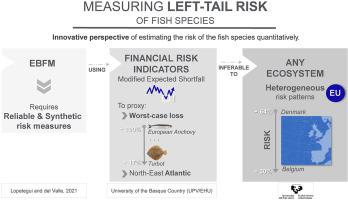Ocean & Coastal Management ( IF 4.8 ) Pub Date : 2021-09-09 , DOI: 10.1016/j.ocecoaman.2021.105872 Itsaso Lopetegui 1 , Ikerne del Valle 1

|
The main objective of this paper is to perform a risk analysis for the key commercial fish species in the FAO area 27 by means of a bundle of financial left-tail risk indicators, including Value-at-Risk (VaR), Expected Shortfall (ES) and Expectiles (EX), and panel data of catches (Qit) to measure the left-tail risk of catches (LTRi); an empirical and probabilistic measure of the worst-case reduction of catches resulting from huge negative shocks. LTRi can be useful, not only to classify the fish species according to their risk level, but also, using the appropriate weights, to infer the risk to any other aggregation level such as fleet, fishing community or fishing country. In this paper, we are employing our species level (LTRi) estimations to calculate the left-tail risk of catches of the EU fishing countries (LTRj), a country level proxy variable for the risk inherent to the fishing activity itself.
中文翻译:

测量鱼类的左尾风险
本文的主要目标是通过一系列财务左尾风险指标,包括风险价值 (VaR)、预期短缺 (ES ) 和预期 (EX),以及捕获量的面板数据 (Q it ) 来衡量捕获量的左尾风险(LTR i );对由巨大的负面冲击造成的最坏情况下的捕捞量减少的经验和概率测量。LTR i不仅可以根据风险级别对鱼类进行分类,还可以使用适当的权重来推断任何其他聚合级别(如船队、渔业社区或渔业国家)的风险。在本文中,我们使用我们的物种水平(LTRi ) 计算欧盟捕捞国家渔获量的左尾风险 (LTR j ) 的估计值,这是捕捞活动本身固有风险的国家级代理变量。











































 京公网安备 11010802027423号
京公网安备 11010802027423号